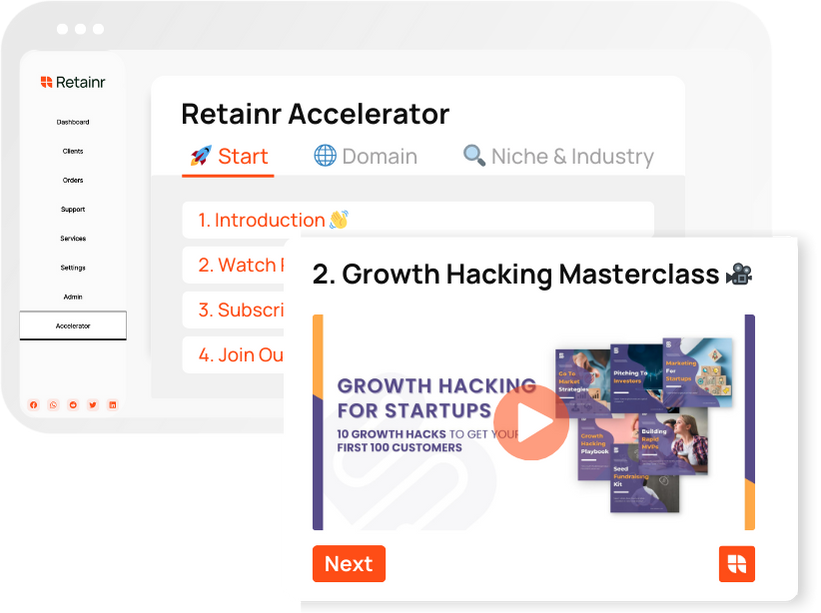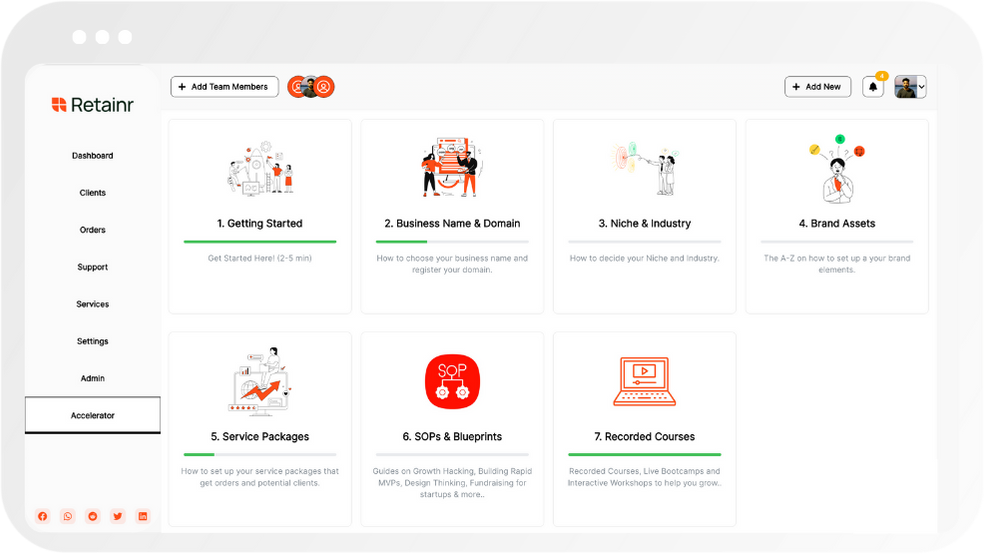
7 Steps to Successfully Automate Your Small Business
Build with Retainr
Sell your products and services, manage clients, orders, payments, automate your client onboarding and management with your own branded web application.
Get Started1. What are the 7 steps to successfully automate my small business?
Identifying Repetitive Tasks
The first step is identifying repetitive tasks. One of the key benefits of automation is the ability to delegate repetitive tasks to software, freeing up your employees to focus on more strategic responsibilities. Start by making a list of tasks that occur regularly, involve clear and predictable steps, and do not require a lot of human judgement or creativity. This might include tasks such as invoicing, tracking sales, and scheduling social media updates.
Choose Appropriate Software
The next step is to decide on the right software for your needs. This will depend on what kind of tasks you are looking to automate. There are many great options available that can help you automate various aspects of your business such as:
- Customer Relationship Management (CRM) software: Shopify, Zoho CRM
- Email Marketing software: Mailchimp, Sendinblue
- Project Management software: Trello, Asana
- Social Media Automation software: Buffer, Hootsuite
- Accounting and Invoicing software: Quickbooks, Xero
Some software will offer more comprehensive features for specific industries, so ensure to do your research and choose software that will serve you best in the long run.
Implementing Automation
The final five steps involve implementing the automation in your business. This would involve:
- Scrutinising free trials/testing periods to ensure the software suits your requirements
- Setting up workflows/processes within the automation software
- Training both employees and management in using the software
- Ensuring the software is working effectively and adjusting workflows as needed
- Periodically reviewing the software’s performance and refining the processes where necessary
By following these seven steps, you should be well on your way towards successfully automating your small business.
2. How does automating a small business benefit its operations?
Benefits of Automating Small Business Operations
Automating tasks in your small business have various benefits that can significantly contribute to improving operations. From an enhanced efficiency to cost savings, automation process can impact different areas of your business:
- Improved Efficiency: Automation reduces the need for manual interventions, leading to quicker processes and increased productivity.
- Reduced Costs: Automating tasks can help eliminate human errors, hence reducing potential costs related to rectifying these mistakes.
- Better Decision Making: Automated systems can provide accurate data, thereby helping business owners make informed decisions.
- Improved Customer Service: With tasks like customer follow-ups and responses being automated, the speed and efficiency of service delivery improve.
Types of Operations that can be Automated
Most small businesses can benefit from implementing automation in a wide range of operations. Based on your company's specific needs, you can automate some or all of these areas:
| Type of Operation | Description |
|---|---|
| Marketing | Automation of email marketing campaigns, social media posting, and other online marketing strategies. |
| Finance | Automating payments, invoicing, payrolls, and other financial operations to avoid errors and save time. |
| Customer Service | Use of chatbots, auto-responders, and other tools to streamline the customer service process. |
| Supply Chain Management | Automation of inventory control, order fulfillment, and other supply chain processes. |
Choosing the Right Automation Tool
Deciding on the right automation tools is a critical step towards successful automation. Here are some key factors to consider:
- Determine what tasks need automation. It's not necessary or even beneficial to automate every process.
- Evaluate available automation tools to identify the one that best suits your needs.
- Calculate the cost of implementing the tool versus the projected economic benefit.
3. How long does it typically take to automate a small business using these 7 steps?
The Time Frame for Business Automation
The timeline for automating a small business using the 7 steps generally depends on several factors including the complexity of the business, the scale of operations, and the tools used for automation. However, it is possible to sketch a rough estimate. For most small businesses, automation can be achieved in a period ranging from a few weeks to a couple of months.
- The initial stages which include assessing your business needs and researching automation tools, could take anywhere between a week to a month, depending on the complexity of the business processes and the time you dedicate to these tasks.
- The next stages involve selecting the right tools, implementing them, and setting up the necessary automation workflows. This phase could take up to a month, or possibly longer, particularly if custom solutions need to be developed or significant changes to business processes are required.
- Finally, training staff and testing the automation systems for any issues is likely to take a further few weeks. Again, this is dependent on the complexity of the systems implemented and the familiarity of staff with the technology.
Operating Timeline Estimation Table
A more detailed estimation might look something like this:
| Stage | Tasks Involved | Estimated Time |
|---|---|---|
| Assessment & Research | Identifying needs and studying automation tools | 1-4 weeks |
| Implementation | Selecting and setting up tools & workflows | 1-2 months |
| Training & Testing | Staff training and system testing | 2-4 weeks |
While these are rough estimations, it is important to take into account that each business is unique, and the actual time taken can vary. Adequate attention should be given to each stage of the process in order to effectively automate your business operations.
4. Are these steps applicable to all types of small businesses?
Applicability of Steps to All Types of Small Businesses
One question that many small business owners may struggle with is whether these automation steps are applicable to all types of small businesses. There’s no one-size-fits-all answer, as the efficiency and success of automation can greatly vary depending on the nature of the business, the chosen systems and resources available. However, for the most part, these steps provide a general guide that could be used by most businesses with various nuances in implementation.
General Application
- Most businesses, regardless of their product or service offering, have repetitive tasks that could be automated to free up time.
- Regardless of industry, customer relationship management is critical. Automation tools can enhance efforts in this area.
- All small businesses can benefit from inventory management and accounting automation.
- Social media and email marketing automation is applicable to businesses in any sector.
A Quick Comparison
| Type of Business | Applicability |
|---|---|
| Retail | Highly applicable. Automation can manage inventory, point of sale systems, and customer relations. |
| Services | Varies. Highly applicable for appointment-based businesses, less so for highly-customized services. |
| Manufacturing | Highly applicable. Automation can streamline production processes, inventory and supply chain management. |
| Food and Beverage | Highly applicable. Can automate order processing, inventory, and customer feedback systems. |
5. Can I automate my small business even with a limited budget?
Automation on a Limited Budget
Contrary to what many believe, automating your small business doesn't necessarily need a hefty investment. It's possible even with a limited budget. All you need to do is first identify the areas that need automation and then choose the tools accordingly. You can prioritize based on the impact and cost-effectiveness of the tool.
- Identify The Areas: List down all tasks that are time-consuming and repetitive. These could be anything from customer support to payroll processing to inventory management. Prioritize them based on the impact on your business and the time it takes.
- Analyze the Cost: Next, go through each task and research the automation tools available. Compare their costs and benefits before making a decision.
- Prioritize: You don't need to automate everything at once. Start with a couple of areas and gradually move to others as your budget allows.
Cost-Effective Automation Tools
There are many automation tools available in the market that suit a varying range of budgets. Here's a list of few tools that prove quite beneficial and cost-effective.
| Tools | Features | Approximate Cost |
|---|---|---|
| Asana | project management, task delegation | $10.99/user/monthly |
| MailChimp | email marketing, ads, landing pages | Free to $299.99/monthly |
| HubSpot | Marketing, sales, CRM, customer service | Free to $3200/monthly |
Utilize Free Trials and Go For Open-Source Solutions
Most tools offer free trials. This will not only help you understand whether the tool is appropriate for your specific requirements, but also give you a fair idea about its ease of use. Also, there are various open-source solutions that are completely free to use. So, when budget is a constraint, go for these options to automate your business efficiently and cost-effectively.
6. What are common challenges when automating a small business and how can they be overcome?
Common Challenges in Automating a Small Business
Despite its numerous advantages, automating a small business may come with a range of challenges. These include:
- Resistance to change: Employees may resist the change due to fear of being rendered redundant.
- Cost considerations: Some business owners can be worried about the financial implication of automation software or tools.
- Lack of technical expertise: Setting up some automation tools could require some level of technical knowledge, which some businesses may lack.
- Data privacy: Automation tools require access to key business data, which brings up concerns about their security and privacy.
Overcoming the Challenges
While these challenges may seem daunting, several strategies can help overcome them. Here are some solutions:
| Challenge | Solution |
|---|---|
| Resistance to change | Transparent communication and training can help employees understand the benefits of automation and see it as an opportunity to improve, not a threat to their jobs. |
| Cost considerations | Calculate the potentially saved time and increased productivity in the long run against the immediate costs. Consider starting with cheaper or free tools and scale up as your savings grow. |
| Lack of technical expertise | When selecting tools, prioritize those that offer user-friendly interfaces and good customer support. Alternatively, outsource the setup process to an expert. |
| Data privacy | Invest in automation tools that prioritize data security and follow best practices to maintain data privacy, such as limiting access and regular audits. |
In Conclusion
Automation in small businesses, while beneficial, certainly comes with its share of challenges. However, with careful planning, open communication, and a bit of strategic investment, these hurdles can be successfully overcome, paving the way for streamlined operations and enhanced productivity.
7. Will automating my small business reduce the need for human workforce?
Impact of Automation on Human Workforce
It's important to be aware that the process of automation can bring about changes in the need for a traditional human workforce. This doesn't necessarily mean that the need for employees will be entirely eliminated.
List of likely impacts:
- Reduction in Manpower: Certain tasks that were previously performed by employees might become automated, reducing the need for workers in those areas. This could potentially lead to downsizing.
- Shift in Roles: While some roles might become obsolete, new roles might also be created, often related to the maintenance and supervision of the new systems.
- Increased Efficiency: Automation often leads to increased productivity and efficiency, which can allow businesses to expand or improve their services, potentially creating room for more or different human roles.
Automation's Role in Workforce Allocation
Although workforce reduction is a possibility, it's also important to note that automation can 'shift' rather than 'reduce' the need for a human workforce. The following table depicts how the roles may shift.
| Before Automation | After Automation |
|---|---|
| Manually performing repetitive tasks | Supervising and maintaining automated systems |
| Performing data entry | Analyzing and making decisions based on data |
| Fixing human errors | Designing and improving automated processes |
Workforce Planning with Automation
So, will automating your small business reduce the need for human workforce? The answer depends on your unique circumstances, the type of business you run, and how you strategize and implement automation into your work processes. Being prepared for changes and taking a proactive role in shaping how automation will impact your business will be a key part of this transition.
8. Which areas of my small business are best suited for automation?
Identifying the Areas Suitable for Automation
Identifying the most suitable areas to automate in your small business largely depends on the nature of your business but, generally, time-consuming routine tasks and tasks prone to human error are ideal for automation. These can include tasks like invoice processing, schedule management, and customer service.
Tasks Ideal for Automation
Areas of a small business that are commonly automated include:
- Invoice Processing: Automated systems can generate invoices, send reminders and manage payments, reducing the chance of human error.
- Schedule Management: Employee work schedules can be automatically managed to ensure staff rotation, vacation coverage, and overtime management.
- Customer Service: Automated customer service systems can handle frequently asked questions, guide customers to the correct department, and even process returns or refunds.
- Email Marketing: An automated system can control email lists, deliver regular email campaigns and analyze the results for you.
Comparing Manual and Automated Tasks
| Tasks | Manual Process Time | Automated Process Time |
|---|---|---|
| Invoice Processing | 4 hours | 30 minutes |
| Schedule Management | 5 hours | 1 hour |
| Customer Service | Varies | Takes much lesser time (instant responses) |
| Email Marketing | 5 hours | 1.5 hours |
The table above gives an idea about the radical time reductions that can be made by automating these common business tasks. Remember, the time you save can be reinvested into more value-adding activities.
9. How can I ensure the smooth implementation of these 7 steps to automation in my business?
Prepare Your Team
Firstly, make sure that your team is ready and fully equipped to handle the changes automation will bring. This includes:
- Proper training and education.
- Setting clear expectations and objectives.
- Regular check-ins to answer questions and address concerns.
Plan and Test Your Automation Processes
Secondly, thorough planning and testing can drastically improve the likelihood of successful implementation. Some steps to consider include:
- Map out your automation processes in detail.
- Check your systems and software compatibility before implementation.
- Conduct a trial run and check for any loopholes or issues.
- Fix any problems discovered during the trial run.
Keep Track of Your Progress
Lastly, monitoring progress is just as crucial to successful implementation. Implement the following measures to ensure that your business automation is running smoothly:
| Measure | Description |
|---|---|
| Regular Reports | Generate regular reports to monitor the performance and efficiency of the automated processes. |
| Feedback | Encourage your team to give feedback on the automation process, addressing any issues or concerns. |
| Review and Adjustment | Regularly review and make necessary adjustments to the automation process to enhance efficiency and productivity. |
10. How can automation help my small business increase efficiency and reduce costs?
Benefits of Automating Your Small Business
Automation can significantly increase the efficiency of your small business and reduce costs in several ways.
- Streamlining Operations: Automation tools can streamline business operations such as billing, payroll processing, and customer service. This helps to reduce human error and saving time.
- Enhanced Customer Experience: With the help of marketing automation software, businesses can personalize customer interactions, ensuring that customers receive tailored offers and emails, which can lead to increased loyalty and sales.
- Improved Decision Making: Automation tools provide valuable insights and data analysis, which can help in making informed business decisions. This means investing money in initiatives that generate returns.
Costs Reduction through Automation
Automating your business operations can reduce costs in the following ways:
| Automation Area | Cost Reduction |
|---|---|
| Payroll Automation | Reduced errors mean fewer penalties and overpayments. |
| Marketing Automation | Targeted campaigns reduce unnecessary marketing expenses. |
| Inventory Automation | Accurate tracking prevents excessive orders and reduces wastage. |
Increasing Efficiency through Automation
Automation has the power to improve business efficiency. Here are some areas where automation can enhance the efficiency:
- Project Management: Automation software can track your projects and deadlines, ensuring everything stays on track.
- Data Entry: Automation reduces time spent on manual data entry, freeing up time for other tasks.
- Communication: Automated emails and notifications can ensure everyone is on the same page in real-time.
Conclusion
Summary
The blog provides invaluable insights into how small business owners can successfully automate their enterprise in seven easy steps. From identifying repetitive tasks to selecting the right tools, it lays out practical steps to free up time, improve efficiency and enhance productivity. Key steps include establishing your automation goals, knowing what to automate, determining the necessary tools, making a plan, implementation, testing, and lastly, training and support. The blog also emphasizes the importance of incorporating an all-inclusive tool like Retainr.io in your business automation strategy.Automate Your Business with Retainr.io
Implementing automation in your small business may sound intimidating, but with the right tool, it can be a straightforward and beneficial process. One such reliable tool is Retainr.io, a versatile white label software designed to handle the Sell, manage clients, orders & payments within Your Own Branded App.Retainr.io can streamline your business operations, automate recurring tasks, and help manage your business more effectively. The software is easy to integrate into your current systems and can be customized to suit your unique business needs.
Why Choose Retainr.io
Choosing Retainr.io for your business automation solutions comes with multiple benefits. Firstly, it can create a personalized app that reflects your brand’s uniqueness, allowing your clients to interact with your business in a more streamlined and professional manner. Secondly, Retainr.io saves you time by efficiently managing sales, client orders, and payments through your brand's app. Lastly, but crucially, its responsive support team is always ready to guide you through the implementation process and provide ongoing support.For a business automation journey that guarantees success, consider using Retainr.io. Enjoy the benefits of improved organization, efficiency, and productivity right at your fingertips.Note: If you want more details about Retainr.io, visit their website or contact their friendly customer service team.Boost Your Agency Growth
with Retainr Accelerator
Uncover secrets, strategies, and exclusive blueprints to take your agency's growth to the next level — from marketing insights to effective presentations and leveraging technology.

SOPs, Cheatsheets & Blueprints
Leverage 50+ SOPs (valued over $10K) offering practical guides, scripts, tools, hacks, templates, and cheat sheets to fast-track your startup's growth.
Connect with fellow entrepreneurs, share experiences, and get expert insights within our exclusive Facebook community.
.jpg)

Join a thriving community of growth hackers. Network, collaborate, and learn from like-minded entrepreneurs on a lifelong journey to success.

Gain expertise with recorded Courses, Live Bootcamps and interactive Workshops on topics like growth hacking, copywriting, no-code funnel building, performance marketing and more, taught by seasoned coaches & industry experts.

.jpg)

.jpeg)


